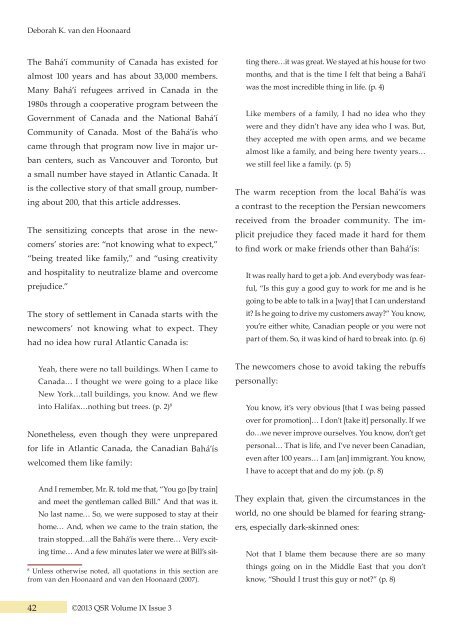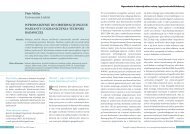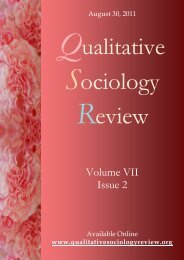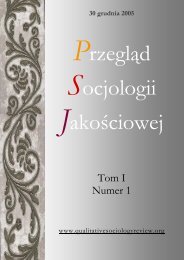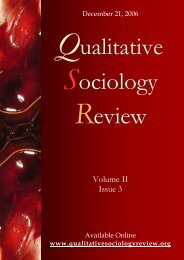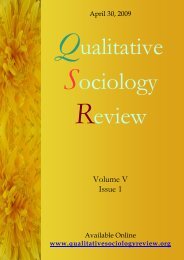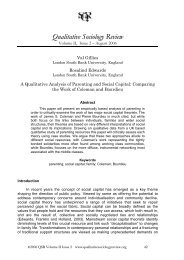Download this issue - Qualitative Sociology Review
Download this issue - Qualitative Sociology Review
Download this issue - Qualitative Sociology Review
You also want an ePaper? Increase the reach of your titles
YUMPU automatically turns print PDFs into web optimized ePapers that Google loves.
Deborah K. van den HoonaardTelling the Collective Story: Symbolic Interactionism in Narrative ResearchThe Bahá’í community of Canada has existed foralmost 100 years and has about 33,000 members.Many Bahá’í refugees arrived in Canada in theting there…it was great. We stayed at his house for twomonths, and that is the time I felt that being a Bahá’íwas the most incredible thing in life. (p. 4)The Bahá’í refugees used hospitality and creativityto address these <strong>issue</strong>s:socially marginalized. In his book, Working withSensitizing Concepts, Will van den Hoonaard (1997)says that sensitizing concepts move us toward1980s through a cooperative program between theGovernment of Canada and the National Bahá’íCommunity of Canada. Most of the Bahá’ís whocame through that program now live in major urbancenters, such as Vancouver and Toronto, buta small number have stayed in Atlantic Canada. Itis the collective story of that small group, numberingabout 200, that <strong>this</strong> article addresses.The sensitizing concepts that arose in the newcomers’stories are: “not knowing what to expect,”“being treated like family,” and “using creativityand hospitality to neutralize blame and overcomeprejudice.”The story of settlement in Canada starts with thenewcomers’ not knowing what to expect. Theyhad no idea how rural Atlantic Canada is:Yeah, there were no tall buildings. When I came toCanada… I thought we were going to a place likeNew York…tall buildings, you know. And we flewinto Halifax…nothing but trees. (p. 2) 8Nonetheless, even though they were unpreparedfor life in Atlantic Canada, the Canadian Bahá’íswelcomed them like family:And I remember, Mr. R. told me that, “You go [by train]and meet the gentleman called Bill.” And that was it.No last name… So, we were supposed to stay at theirhome… And, when we came to the train station, thetrain stopped…all the Bahá’ís were there… Very excitingtime… And a few minutes later we were at Bill’s sit-8Unless otherwise noted, all quotations in <strong>this</strong> section arefrom van den Hoonaard and van den Hoonaard (2007).Like members of a family, I had no idea who theywere and they didn’t have any idea who I was. But,they accepted me with open arms, and we becamealmost like a family, and being here twenty years…we still feel like a family. (p. 5)The warm reception from the local Bahá’ís wasa contrast to the reception the Persian newcomersreceived from the broader community. The implicitprejudice they faced made it hard for themto find work or make friends other than Bahá’ís:It was really hard to get a job. And everybody was fearful,“Is <strong>this</strong> guy a good guy to work for me and is hegoing to be able to talk in a [way] that I can understandit? Is he going to drive my customers away?” You know,you’re either white, Canadian people or you were notpart of them. So, it was kind of hard to break into. (p. 6)The newcomers chose to avoid taking the rebuffspersonally:You know, it’s very obvious [that I was being passedover for promotion]… I don’t [take it] personally. If wedo…we never improve ourselves. You know, don’t getpersonal… That is life, and I’ve never been Canadian,even after 100 years… I am [an] immigrant. You know,I have to accept that and do my job. (p. 8)They explain that, given the circumstances in theworld, no one should be blamed for fearing strangers,especially dark-skinned ones:Not that I blame them because there are so manythings going on in the Middle East that you don’tknow, “Should I trust <strong>this</strong> guy or not?” (p. 8)They’re scared… But, we showed our love, we showall of it, we show all our love, and, “How are you?Good morning.” (p. 8)The collective story includes a combination of creativityand hospitality. Here is a signature story ofPersian Bahá’í refugees in Atlantic Canada:[I heard from a neighbor that] “people think thatyou have a rifle in your basement, and you arewaiting for some good opportunity to attack”… I said, “No [we don’t have such things], youcan come and visit us.” Later on, they came overand, on purpose, I said, “Okay, I want to give youa tour of my house.” You know, let’s see the bedroom,and… I take them to the basement, and hereis the laundry room, here is the workshop…justshow them everything, and now they are very,very friendly. When they have any family problemthey come over here, and they ask us to solve theirproblem. (p. 10)The collective story of the Iranian Bahá’í newcomersincludes the persecution that drove them out oftheir homeland and tells how they were welcomedto their new homes, the barriers they faced, andtheir efforts to overcome those barriers. The sensitizingconcepts provide an entry to understandinghow these immigrants interpreted and dealt withtheir situation.ConclusionThis article has focused on three studies to demonstratehow sensitizing concepts can assist us toconstruct the collective story of groups who aremore abstract or general theorizing. This articlesuggests that they can also be the building blocksof a collective story.Laurel Richardson writes that although a collectivestory is about a category of people rather thanindividuals, “the individual response to a welltoldcollective story is, ‘That’s my story. I am notalone’” (1990:26). She argues that the collectivestory should be written in language that is accessibleto members of the social category it involves(1988) as a means of constructing a “consciousnessof kind…a concrete recognition of sociologicalbondedness [which can] break down isolation[and potentially] alter the system” (Richardson2000:336).It appears that the widows’ collective story, told inThe Widowed Self (van den Hoonaard 2001), has met<strong>this</strong> standard. When an article about my new researchon widowhood appeared in the local newspaper,one of the volunteers for the study said thatshe had read the book, found it very helpful, andwanted to be interviewed for the new study to helpother widows.This article has demonstrated the usefulnessof sensitizing concepts in the construction andtelling of a collective story. Because sociologistsdevelop these concepts inductively and use thelanguage of research participants to name andformulate them, they have a unique potential tocontribute to collective stories that are both powerfuland accessible to scholars and members ofcategories whose story is being told.42©2013 QSR Volume IX Issue 3<strong>Qualitative</strong> <strong>Sociology</strong> <strong>Review</strong> • www.qualitativesociologyreview.org 43


